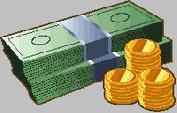
 |
|
| Financial Terms | |
| Negative Loan Covenants |
|
Information about financial, finance, business, accounting, payroll, inventory, investment, money, inventory control, stock trading, financial advisor, tax advisor, credit.
Main Page: stock trading, financial advisor, tax advisor, inventory control, financial, money, accounting, credit, |
Definition of Negative Loan Covenants
Negative Loan Covenantsloan covenants designed to limit a corporate borrower's behavior
Related Terms:Back-to-back loanA loan in which two companies in separate countries borrow each other's currency for a Broker loan rateRelated: Call money rate. Builder buydown loanA mortgage loan on newly developed property that the builder subsidizes during the Bullet loanA bank term loan that calls for no amortization. CovenantsProvisions in a bond indenture or preferred stock agreement that require the bond or preferred Dealer loanOvernight, collateralized loan made to a dealer financing his position by borrowing from a Equivalent loanGiven the after-tax stream associated with a lease, the maximum amount of conventional  Federal Home Loan BanksThe institutions that regulate and lend to savings and loan associations. The Fixed-rate loanA loan on which the rate paid by the borrower is fixed for the life of the loan. Freddie Mac (Federal Home Loan Mortgage Corporation)A Congressionally chartered corporation that Intercompany loanloan made by one unit of a corporation to another unit of the same corporation. Inventory loanA secured short-term loan to purchase inventory. The three basic forms are a blanket Jumbo loanloans of $1 billion or more. Or, loans that exceed the statutory size limit eligible for purchase or Loan amortization scheduleThe schedule for repaying the interest and principal on a loan. Loan syndicationGroup of banks sharing a loan. See: syndicate. Loan valueThe amount a policyholder may borrow against a whole life insurance policy at the interest rate  Multicurrency loansGive the borrower the possibility of drawing a loan in different currencies. Multifamily loansloans usually represented by conventional mortgages on multi-family rental apartments. Negative amortizationA loan repayment schedule in which the outstanding principal balance of the loan Negative carryRelated: net financing cost Negative convexityA bond characteristic such that the price appreciation will be less than the price Negative covenantA bond covenant that limits or prohibits altogether certain actions unless the bondholders agree. Negative durationA situation in which the price of the MBS moves in the same direction as interest rates. Negative pledge clauseA bond covenant that requires the borrower to grant lenders a lien equivalent to any Parallel loanA process whereby two companies in different countries borrow each other's currency for a Project loan certificate (PLC)A primary program of Ginnie Mae for securitizing FHA-insured and coinsured Project loan securitiesSecurities backed by a variety of FHA-insured loan types - primarily multi-family Project loansUsually FHA-insured and HUD-guaranteed mortgages on multiple-family housing complexes, Restrictive covenantsProvisions that place constraints on the operations of borrowers, such as restrictions on Savings and Loan associationNational- or state-chartered institution that accepts savings deposits and Self-liquidating loanloan to finance current assets, The sale of the current assets provides the cash to repay Term loanA bank loan, typically with a floating interest rate, for a specified amount that matures in between Transaction loanA loan extended by a bank for a specific purpose. In contrast, lines of credit and revolving Variable rate loanloan made at an interest rate that fluctuates based on a base interest rate such as the Loans payableAmounts that have been loaned to the company and that it still owes. negative cash flowThe cash flow from the operating activities of a business Negative goodwillA term used to describe a situation in which a business combination Loan CovenantsExpress stipulations included in loan agreements that are designed to monitor Positive Loan Covenantsloan covenants expressing minimum and maximum financial measures Bridge LoanA short term loan to cover the immediate cash requirements until permanent financing is received. CovenantsPromise usually made in a contract whereby a party to the contract promises to do or not to do specified things. Demand LoanA loan which must be repaid in full on demand. Farm Improvement and Marketing Cooperatives Loans ActSee here Financial CovenantsA promise made related to financial conditions or events. Often a promise not to allow certain balance sheet items or ratios to fall below an agreed level. Usually found in loan documents, as a protection mechanism. Fixed Rate Loanloan for a fixed period of time with a fixed interest rate for the life of the loan. Loan CapitalBorrowed funds having a fixed interest rate. Operating LoanA loan advanced under an operating line of credit. Term LoanA secured loan made to business concerns for a specific period (normally three to ten years). It is repaid with interest, usually with periodical payments. personal loanA lump sum that you borrow from a financial institution for a specified period of time. To repay the loan, you pay interest on the entire lump sum, and make payments on a scheduled basis. secured loan or line of creditA lump sum of funds (loan), or a revolving source of credit with a pre-established limit (line of credit), for which the customer must provide collateral. Commercial Business Loan (Credit Insurance)An agreement between a creditor and a borrower, where the creditor has loaned an amount to the borrower for business purposes. Related to : financial, finance, business, accounting, payroll, inventory, investment, money, inventory control, stock trading, financial advisor, tax advisor, credit. |